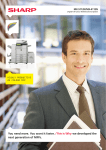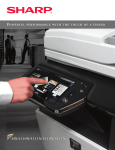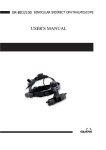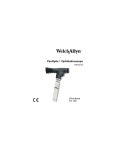Download - American Diagnostic Corporation
Transcript
Troubleshooting The following guidelines should be used to determine if your device has reached its end of life or requires servicing. If the corrective actions described in this section do not resolve your issues, please see the warranty section of this manual to have your device serviced. Pocket Diagnostic Instruments Use, Care, & Maintenance Otoscope and accessories Troubleshooting Guide Trouble Area Possible Cause Corrective Action Lamp burned out Replace the lamp Wrong Lamp Installed Replace the lamp Batteries are depleted Replace with fresh “AA” batteries Lamp not fully inserted Re-insert lamp Thread/connection is damaged Service required Wrong specula used Use only Welch Allyn brand or compatible Trouble Area Possible Cause Corrective Action Specula will not attach properly Specula mount is damaged Service required Loose or misaligned magnifying lens Lens mount is damaged Service required Lens is dirty Clean with lint free cloth Lens is damaged Service required Lamp near end of useful life Replace the lamp No light output Instrument head will not connect Poor or obstructed view through lens Dim light output Batteries are depleted Replace with fresh “AA” batteries Visible corrosion on instrument or accessories Damage from excessive moisture Service required LIMITED WARRANTY American Diagnostic Corporation (ADC®) warrants its products against defects in materials and workmanship under normal use and service as follows: 1. Warranty service extends to the original retail purchaser only and commences with the date of delivery. 2. The instruments are warranted for one year. The LED lamps are warranted for life. What is Covered: Repair, or replacement of parts, and labor. Ophthalmoscope Troubleshooting Guide Trouble Area Possible Cause Corrective Action Aperture dial is between positions Rotate Aperture dial Lamp burned out Replace the lamp Wrong lamp installed Replace the lamp Batteries are depleted Replace with fresh “AA” batteries Lamp not fully inserted Re-insert lamp Thread/connection is damaged Service required The aperture dial is not centered Move aperture dial to the full detent position Lamp near end of useful life Replace the lamp Batteries are depleted Replace with fresh “AA” batteries Aperture or lens wheel will not turn or does so with difficulty Dirt in or damage to mechanism Service required Visible corrosion on instrument Damage from excessive moisture Service required No light output Instrument head will not connect Spot is not centered Dim light output What is Not Covered: Transportation charges to ADC®. Damages caused by abuse, misuse, accident, or negligence. Incidental, special, or consequential damages. Some states do not allow the exclusion or limitation of incidental, special, or consequential damages, so this limitation may not apply to you. To Obtain Warranty Service: Devices should be contained in their transport/storage cases when being returned to ADC® to ensure that they are not damaged during transport and handling. Do not ship contaminated devices or storage cases to ADC®’s facility. Send item(s) postage paid to ADC®, Attn: Repair Dept., 55 Commerce Dr., Hauppauge, NY 11788. Please include your name and address, phone no., proof of purchase, and a brief note explaining the problem. Implied Warranty: Any implied warranty shall be limited in duration to the terms of this warranty and in no case beyond the original selling price (except where prohibited by law). This warranty gives you specific legal rights and you may have other rights which vary from state to state. To Register Your Product, visit us at www.adctoday.com and follow the links Environment Transportation / Storage: -20°C to +49°C (-4°F to 120.2°F) Relative Humidity: 95 % 500 hpa – 1060 hpa, Altitude Environmental Operating Range: 10°C to 49°C (50°F to 120.2°F) RH 95 % (Max) 500 hpa – 1060 hpa, Altitude Max. Operating: 35°C (95°F) ADC 55 Commerce Drive Hauppauge, NY 11788 ADC (UK) Ltd. Unit 6, PO14 1TH United Kingdom Inspected, assembled and packaged in the U.S.A. Components made in Dubai tel: 631-273-9600 toll free: 1-800-232-2670 fax: 631-273-9659 www.adctoday.com info@adctoday.com IB p/n 9362-00 rev 5 Printed in the U.S.A. Thank you for choosing an ADC® Diagnostic set. We’re proud of the care and quality that goes into the manufacture of each and every diagnostic instrument that bears our name. Every component has been carefully designed to maximize performance. This booklet refers to both Otoscope and Ophthalmoscope sets (Models 5110N Series, 5110E, 5111N Series, 5112N Series). Device Description and Intended Use Pneumatic Otoscope To perform, insert tapered end of insufflator fitting (5121N) sold separately, into hole on side of Otoscope head. Attach optional bulb assembly (5122N) sold separately. Ophthalmoscope Parts and Assembly Ophthalmoscope attachment (5110N Series, 5110E, 5112N Series) The ophthalmoscope is a handheld, battery-powered device containing illumination and viewing optics intended to examine the media (cornea, aqueous, lens, and vitreous), the retina, blood vessels, optic nerve, and other structures of the eye. It is intended to be used by a trained healthcare professional. The Pocket Ophthalmoscope consists of a “AA” battery handle (5160N) and Ophthalmoscope instrument head (5140N Series). Aperture Selection This unit is equipped with 5 internal apertures - small, large, semi-circle, red-free, and fixation. To select, rotate the aperture selection wheel at the front of the instrument head. Otoscope Attachment (5110N Series, 5110E, 5111N Series) A handheld battery powered device with magnifying system that provides illumination of the ear canal and tympanic membrane. Latex Statement - This device and all accessories are not made with natural rubber latex. This device should be used by a trained healthcare professional. Corrective Lens Selection This unit is equipped with 19 corrective lenses from +20 to 20 diopters (negative lenses in red). To select, rotate the corrective lens selection wheel at either side of the instrument head. Selected lenses can be viewed in the lighted panel on practitioner side of instrument. Contraindications The use of this device is contraindicated in patients who have already received prolonged or intense light exposure, especially if the patients are infants, aphakes, or persons with diseased eyes. Excessive exposure to light may result in patient injury. See warnings for additional information. Symbol Definitions The following symbols are associated with your aneroid sphygmomanometer. OFF Symbol Definition Symbol Definition ON Attention. Read Operating Manual for Cautions and Instructions for Use. LATEX Not made with natural rubber latex Authorized European Represenative’s Information Turning Instrument On To illuminate, slide the on/off switch located on the battery handle pocket clip away from the instrument head. Slide the switch in the opposite direction to turn off. Manufacturer’s Information Replacing Lamp Remove the Instrument head by turning counterclockwise. Grab end of lamp from inside base of instrument head and remove. Replace with new lamp, taking care not to touch glass, and align lamp metal guides on side of lamp with grooves in lamp socket. TYPE B. Indicates this is a product with Type B applied parts Conforms to EU Standards Do not dispose of this product as unsorted municipal waste General Warnings A warning statement in this manual identifies a condition or practice which, if not corrected or discontinued immediately, could lead to patient injury, illness, or death. NOTE: Allow lamp to cool for five minutes before handling if device has been recently used. *NOTE: Otoscope LED lamp cannot be replaced, must order new head with lamp. CAUTION: Because prolonged intense light exposure can damage the retina, the use of the device for ocular examination should not be unnecessarily prolonged, and the brightness setting should not exceed what is needed to provide clear visualization of the target structures. Lamp Replacement Part Numbers Lamp Type Otoscope The retinal exposure dose for a photochemical hazard is a product of the radiance and the exposure time. If the value of radiance were reduced in half, twice the time would be needed to reach the maximum exposure limit. While no acute optical radiation hazards have been identified for direct or indirect ophthalmoscopes, it is recommended that the intensity of light directed into the patient's eye be limited to the minimum level which is necessary for diagnosis. Infants, aphakes and persons with diseased eyes will be at greater risk. The risk may also be increased if the person being examined has had any exposure with the same instrument or any other ophthalmic instrument using a visible light source during the previous 24 hours. This will apply particularly if the eye has been exposed to retinal photography. CAUTION: Federal law restricts this device to sale by or on the order of a physician or licensed healthcare practitioner. WARNING: The carrying cases provided with these devices are intended for long term storage or transport between facilities or when shipping devices to and from ADC’s facility for repair or servicing. Carry cases (including internal liners) can NOT be cleaned or disinfected and should be safely discarded if contaminated. Do not carry the case into a contaminated environment. WARNING: When replacing lamp, allow lamp to cool for five minutes before handling. WARNING: No form of sterilization has been validated for this device or its corresponding components and sterilization may compromise the safety and effectiveness of this device. (This includes steam sterilization.) WARNING: Do NOT place devices or accessories back into carrying case after use on a patient without first cleaning/disinfecting the device/accessories as described in the cleaning and disinfection section of this manual. Carry case liners can NOT be cleaned or disinfected and should be discarded if contaminated. WARNING: Use of any accessories or materials not indicated in the user's manual can degrade the minimum safety of the equipment. WARNING: Only replace listed accessories (attachments), lamps, or batteries for the device. WARNING: During use metal components near instrument head can become warm. This is especially true if device is on for extended periods of time. Do not leave device on when not in use. WARNING:The light emitted from this instrument is potentially hazardous. The longer the duration of exposure, the greater the risk of ocular damage. Exposure to light from this instrument, when operated at maximum intensity, will exceed the safety guideline after 3 minutes and 47 seconds. Exposure times are cumulative for a 24 hour period. Otoscope Parts and Assembly The Pocket Otoscope consists of a “AA” battery handle (#5160N), fiberoptic Otoscope Instrument Head (5120N Series), with attached movable viewing lens, and disposable specula (2.75mm and 4.25mm). Removing and Attaching the Instrument Head Pocket otoscope heads are threaded and can be removed by rotating the threaded connection counterclockwise, or attached by rotating the threaded connection clockwise. Viewing Lens To move during an examination, turn the lens bezel clockwise to lift up. To reposition, reverse procedure. Attaching the Disposable Specula Push the flanged end of the desired speculum onto the chrome socket and twist counterclockwise to engage. Reverse procedure to remove and discard after each use. 5111N-4 5112N-4 LED 5120NL* 5112NL-4 Battery Replacement This unit requires 2 “AA” batteries. For best performance, we suggest alkaline batteries. To replace, remove the battery cap at the base of the handle by turning counterclockwise and replace batteries, taking care to observe correct polarity. ➞ CAUTION: Do NOT immerse the battery handle in liquid. Consult the cleaning and disinfection instructions for each part for further information about cleaning and disinfecting this product. Never clean or disinfect any device with batteries in it. Ophthalmoscope Hal/Xenon NOTE: : This instrument should be turned OFF when not in use. If storing for extended lengths of time, remove batteries completely. Handle Care and Maintenance Periodically check the condition of both the batteries, making sure there is no sign of corrosion or oxidation. Always replace BOTH batteries. Alkaline batteries are recommended. Remove batteries from handle if instrument will not be used for an extended period of time. Cleaning and Disinfection Basic Cleaning Procedure for Battery Handles, Otoscope and Ophthalmoscope Heads To clean the exterior of the device, prepare a 70% isopropyl alchohol solution and soak a lint-free cloth. Wipe down the exterior of the ophthalmoscope head and handle, cleaning all external surface areas. Care should be taken to prevent excess liquid from seeping into the components. Isopropyl alchohol may be substituted with commonly used, EPA-registered hospital disinfectant wipes for cleaning purposes if desired. Please refer to the directions provided by the manufacturer of the wipes for appropriate instructions for use to ensure effective contact time between the wipe and the device. It is important to note that solution residue on the magnifying lenses may decrease device performance. All excess cleaning fluids must be carefully wiped clean if these surfaces are cleaned. The lenses of the instrument head may be cleaned with a lintfree cloth or lens paper.. Disposable Specula Cleaning/Disinfection Instructions Disposable specula should not be cleaned or disinfected in any way. Disposable specula are single patient use only and must be discarded after use. Disposable specula should not be used if they appear to be visibly contaminated or have accidentally come into contact with contaminated materials prior to use.























